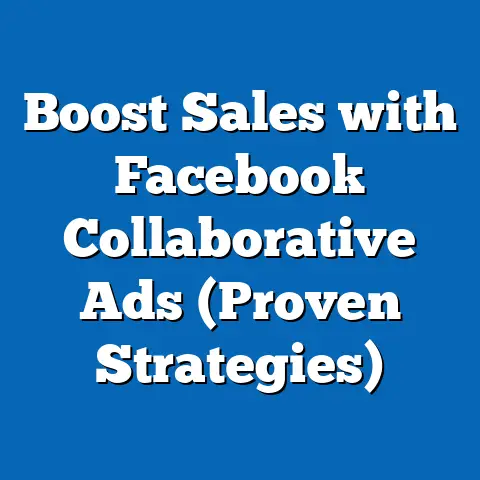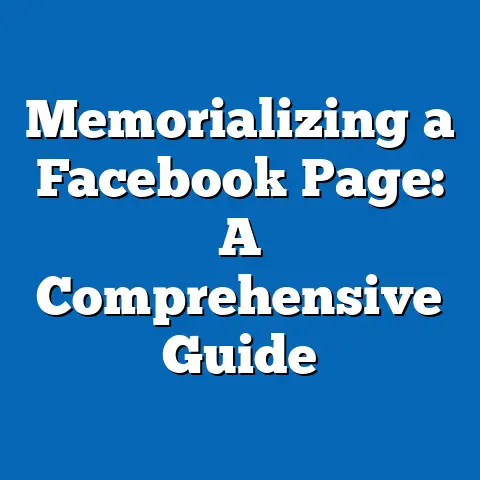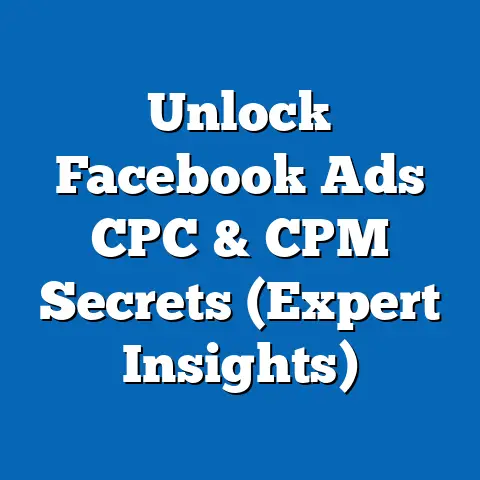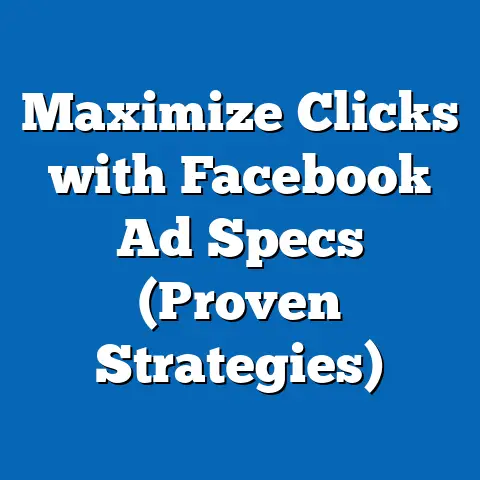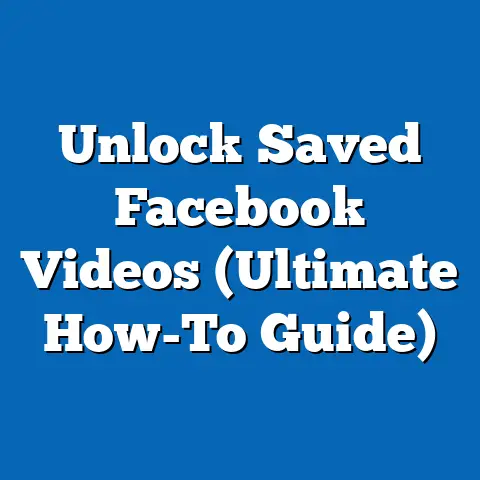Master Facebook Side Ads (Proven Strategies for Success)
In the ever-evolving landscape of digital advertising, innovation is the name of the game. We’ve witnessed a monumental shift from traditional billboards and print ads to dynamic, targeted online campaigns. At the forefront of this transformation stands Facebook, a platform that has not only connected billions of people but has also revolutionized how businesses reach their audiences. One of Facebook’s key innovations is the introduction of Side Ads, a responsive feature designed to enhance user experience and engagement.
I remember when Facebook first started rolling out Side Ads. Initially, I was skeptical. Would they be as effective as the traditional newsfeed ads? But as I began to experiment with them, I quickly realized their potential. Their unobtrusive placement allowed for a unique opportunity to capture attention without disrupting the user’s browsing experience.
Mastering Facebook Side Ads is no longer optional; it’s essential for any business looking to thrive in today’s digital marketing landscape. In this guide, I’ll share proven strategies to help you unlock the full potential of Side Ads and drive meaningful results for your business.
Understanding Facebook Side Ads
Facebook Side Ads, also known as right-column ads, are a type of advertisement displayed on the right side of the Facebook interface on desktop computers. Unlike newsfeed ads that seamlessly integrate into the user’s content stream, Side Ads occupy a dedicated space, offering a less intrusive yet highly visible placement.
The mechanics of Side Ads are relatively straightforward. Advertisers can target specific demographics, interests, behaviors, and locations, just like with other Facebook ad formats. However, the visual and textual elements of Side Ads need to be carefully crafted to capture attention in a smaller space.
The significance of Side Ads lies in their ability to complement other advertising efforts on Facebook. They offer a different avenue for reaching potential customers, particularly those who may not be actively scrolling through their newsfeeds. By incorporating Side Ads into your overall Facebook advertising strategy, you can increase brand visibility, drive traffic to your website, and generate leads.
Takeaway: Facebook Side Ads offer a unique and valuable advertising opportunity. Understanding their mechanics and significance is the first step towards mastering them.
Proven Strategies for Crafting Compelling Side Ads
Creating effective Facebook Side Ads requires a strategic approach that focuses on audience targeting, compelling creative elements, and continuous optimization. Here are some proven strategies to help you craft Side Ads that drive results:
Audience Targeting
One of the most critical aspects of any successful Facebook ad campaign is identifying and understanding your target audience. Before you even begin creating your ad, take the time to research your ideal customer. Who are they? What are their interests? What problems are they trying to solve?
Facebook’s audience segmentation tools provide a wealth of options for refining your ad reach. You can target users based on:
- Demographics: Age, gender, education, relationship status, etc.
- Interests: Hobbies, activities, pages they’ve liked, etc.
- Behaviors: Purchase history, device usage, travel habits, etc.
- Location: Country, region, city, zip code, etc.
- Custom Audiences: Uploaded customer lists, website visitors, app users, etc.
- Lookalike Audiences: Users who share similar characteristics with your existing customers.
Experiment with different targeting options to find the audiences that are most responsive to your ads. I’ve found that creating highly specific audience segments often leads to better engagement and conversion rates.
Takeaway: Precise audience targeting is the foundation of successful Side Ads. Use Facebook’s tools to identify and reach your ideal customer.
Ad Creative Elements
The creative elements of your Side Ads are what will ultimately capture the attention of your target audience. These elements include the visuals, the ad copy, and the call-to-action (CTA).
- Visuals: Side Ads have a limited amount of space, so your visuals need to be eye-catching and relevant. Use high-quality images or videos that clearly communicate your message. Consider using bright colors, bold fonts, and compelling imagery that stands out from the surrounding content. I’ve personally seen a significant boost in click-through rates when using visuals that are visually appealing and directly related to the product or service being advertised.
- Copy: Your ad copy should be concise, persuasive, and benefit-driven. Highlight the key benefits of your product or service and explain how it can solve your target audience’s problems. Use strong verbs and persuasive language to encourage clicks. Keep your copy short and sweet, as Side Ads have limited space.
- Call-to-Action (CTA): Your CTA is the final push that encourages users to take action. Use clear and compelling CTAs such as “Shop Now,” “Learn More,” “Sign Up,” or “Get Started.” Make sure your CTA is prominently displayed and easy to click.
Takeaway: Compelling creative elements are essential for capturing attention and driving clicks. Focus on high-quality visuals, persuasive copy, and clear calls-to-action.
A/B Testing and Optimization
No matter how well you plan your Side Ads, you’ll never know what truly resonates with your audience until you start testing. A/B testing involves creating multiple versions of your ad with slight variations in the visuals, copy, or targeting options. By running these ads simultaneously, you can see which versions perform best and optimize your campaigns accordingly.
Here are some best practices for A/B testing:
- Test one element at a time: To accurately measure the impact of each change, only vary one element at a time. For example, test different headlines while keeping the visuals and targeting the same.
- Use a control group: Always have a control group (the original ad) to compare your variations against.
- Track your results: Monitor key metrics such as click-through rate (CTR), conversion rate, and cost per acquisition (CPA) to determine which variations are performing best.
- Iterate and optimize: Based on your results, make changes to your ads and continue testing. Optimization is an ongoing process.
I’ve personally seen campaigns transformed through consistent A/B testing. Small tweaks to the headline or CTA can often lead to significant improvements in performance.
Takeaway: A/B testing is crucial for optimizing your Side Ads. Continuously test different elements to identify what resonates best with your audience.
Budgeting and Bidding Strategies
Setting a realistic budget for your Facebook Side Ads is essential for achieving your business goals without overspending. Consider your overall marketing budget, the potential return on investment (ROI) of your ads, and the specific goals you’re trying to achieve.
Facebook offers several bidding strategies to choose from, including:
- Cost-Per-Click (CPC): You pay each time someone clicks on your ad. This is a good option if your goal is to drive traffic to your website.
- Cost-Per-Impression (CPM): You pay for every 1,000 impressions your ad receives. This is a good option if your goal is to increase brand awareness.
- Cost-Per-Action (CPA): You pay when someone takes a specific action, such as making a purchase or filling out a form. This is a good option if your goal is to generate leads or drive conversions.
The right bidding strategy will depend on your specific goals and budget. I recommend experimenting with different strategies to see which one delivers the best results for your business.
Here are some tips for allocating your budget effectively:
- Start small: Begin with a small budget and gradually increase it as you see positive results.
- Set daily or lifetime budgets: Facebook allows you to set daily or lifetime budgets for your campaigns. This helps you control your spending and avoid overspending.
- Monitor your performance: Regularly monitor your ad performance and make adjustments to your budget as needed.
Takeaway: Effective budgeting and bidding strategies are crucial for maximizing your ROI. Set a realistic budget, choose the right bidding strategy, and monitor your performance closely.
Case Studies of Successful Facebook Side Ads Campaigns
To illustrate the power of Facebook Side Ads, let’s examine a few case studies of businesses that have successfully utilized this ad format to achieve their goals:
Case Study 1: E-commerce Brand – Increased Brand Awareness and Website Traffic
A small e-commerce brand specializing in handmade jewelry wanted to increase brand awareness and drive traffic to their website. They created a series of Side Ads featuring high-quality images of their jewelry and compelling ad copy highlighting the unique craftsmanship and materials used. They targeted users interested in fashion, jewelry, and handmade goods.
The results were impressive. The campaign generated a significant increase in brand awareness, with a 30% increase in website traffic and a 15% increase in sales.
Key Lessons Learned:
- High-quality visuals are essential for capturing attention.
- Targeting users interested in specific products or services can lead to better results.
- Side Ads can be effective for driving website traffic and increasing sales.
Case Study 2: Local Restaurant – Lead Generation and Reservations
A local restaurant wanted to generate more leads and increase reservations. They created Side Ads featuring mouth-watering images of their dishes and ad copy highlighting their unique menu and ambiance. They targeted users within a specific geographic area who were interested in dining out and local restaurants.
The campaign generated a significant increase in lead generation, with a 20% increase in reservations and a 10% increase in overall revenue.
Key Lessons Learned:
- Targeting users within a specific geographic area can be effective for local businesses.
- Highlighting unique menu items and ambiance can attract potential customers.
- Side Ads can be effective for generating leads and increasing reservations.
Takeaway: These case studies demonstrate the potential of Facebook Side Ads to achieve a variety of business goals. By following the strategies outlined in this guide, you can create successful campaigns that drive results for your business.
Common Pitfalls to Avoid
While Facebook Side Ads can be a powerful advertising tool, there are several common pitfalls that businesses should avoid:
- Poorly targeted ads: Targeting the wrong audience can lead to wasted ad spend and poor results.
- Low-quality visuals: Using blurry, pixelated, or irrelevant images can turn off potential customers.
- Unclear ad copy: Ad copy that is confusing, poorly written, or doesn’t highlight the benefits of your product or service can fail to capture attention.
- Weak calls-to-action: Failing to include a clear and compelling CTA can leave potential customers wondering what to do next.
- Ignoring ad performance: Failing to monitor your ad performance and make adjustments as needed can lead to wasted ad spend and missed opportunities.
I’ve seen countless campaigns fail due to these common mistakes. By avoiding these pitfalls, you can significantly increase your chances of success with Facebook Side Ads.
Takeaway: Avoid common mistakes such as poor targeting, low-quality visuals, unclear ad copy, weak calls-to-action, and ignoring ad performance.
Conclusion
Mastering Facebook Side Ads is essential for any business looking to thrive in today’s digital marketing landscape. By understanding the mechanics of Side Ads, crafting compelling creative elements, implementing effective budgeting and bidding strategies, and avoiding common pitfalls, you can unlock the full potential of this powerful advertising tool.
I encourage you to apply the proven strategies shared in this guide to enhance your own advertising efforts on Facebook. With the right approach, Facebook Side Ads can transform your business’s marketing strategy and drive meaningful results. The potential is there; it’s up to you to seize it!

